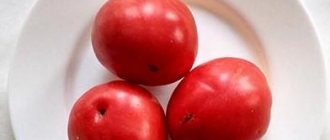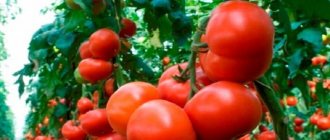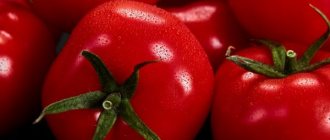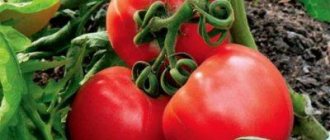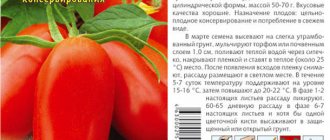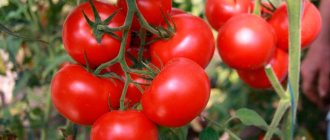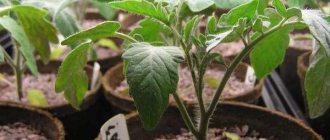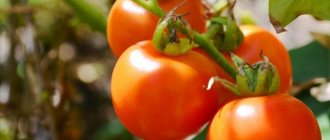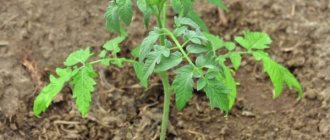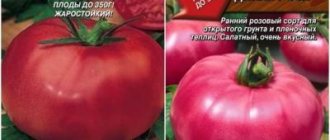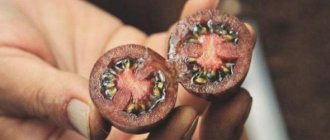You don’t need any exhausting physical labor or time to grow an Irishka F1 tomato. A high-yielding hybrid is a worthy reward for every farmer for basic care. The fruits have excellent taste, beautiful appearance and can be used in a huge number of dishes - fresh, hot, winter.
| Height | Landing location | Ripening time | Fruit color | Fruit size | Origin | Fruit shape |
| short | Greenhouse, Open ground | Early ripening | Reds | Average | Hybrid | Round |
Tomatoes "Irishka F1": description of the variety
| Variety name | Irishka |
| general description | Early maturing hybrid |
| Originator | Kharkiv |
| Ripening period | 80-90 days |
| Form | Rounded |
| Color | Scarlet |
| Average weight of tomatoes | 100-130 grams |
| Application | Universal |
| Productivity of the variety | 9-11 kg per square meter |
| Features of cultivation | Standard agricultural technology |
| Disease resistance | Prevention of late blight is necessary |
The hybrid was created at the Institute of Melon and Vegetable Growing of the UAAS in Kharkov.
The State Register recommends it for cultivation in the Central region and the North Caucasus district. Irishka is a hybrid variety of tomatoes F1. It is a determinate plant of medium height. Read about indeterminate varieties here. It reaches a height of 60–80 cm . The formation of the first inflorescence occurs on the 5th or 6th leaf.
The Irishka tomato variety is an early ripening variety; the fruits begin to ripen 80–90 days after germination. Tomatoes of this variety can be grown both in open soil and in greenhouses, under film in glass and polycarbonate greenhouses.
The hybrid is very resistant to the attack of the tobacco mosaic virus and microsporosis.
Further care
By providing the Irina F1 plant with proper care, gardeners can achieve amazing results.
Watering and fertilizing
Tomatoes should be watered exclusively at the root of the plant to avoid unnecessary wetting of the foliage. The liquid should not have a too low temperature; it is best to let it brew under the sun's rays. After 10-15 minutes of soil moistening, the area under the bushes needs to be slightly loosened. This will help prevent water stagnation.
At the stage of fruit formation, the plant must be fed with phosphorus fertilizers.
Loosening and removing weeds
Loosening, mulching and removing weeds must be carried out every 10 days
This is an important condition for the full formation of a tomato.
Bush formation
Although the plant of this variety has fairly strong trunks and is not very tall, experienced farmers strongly recommend gartering the crop with separate shrubs. They explain this by the fact that the Irina F1 tomato grows extremely heavy bunches that can cause significant damage to the stems.
Hybrid plants that have 2 or 3 branches give a bountiful harvest. This variety is best formed from 1 or 2 trunks.
Diseases and pests: preventive measures
With proper care, this variety of tomato remains absolutely resistant to all kinds of diseases. Breeders have done everything to develop a variety that can tolerate any disease. The gardener is only required to care for and water the plant on time, and in this case even late blight will bypass the tomato bushes.
Characteristics
Irishka is classified as a hybrid with good yield. On average, 9–11 kg of tomatoes are harvested from one square meter of plantings. Per hectare - 230–540 kg. The maximum recorded yield is 828 kg per hectare.
You can compare the yield of this variety with others in the table below:
| Variety name | Productivity |
| Irishka | 9-11 per square meter |
| Gulliver | 7 kg per bush |
| Lady Shady | 7.5 kg per square meter |
| Honey Heart | 8.5 kg per square meter |
| Fat Jack | 5-6 kg per bush |
| Doll | 8-9 kg per square meter |
| Summer resident | 4 kg per bush |
| Lazy | 15 kg per square meter |
| The president | 7-9 kg per square meter |
| King of the market | 10-12 kg per square meter |
The advantages include:
- excellent productivity;
- unpretentiousness;
- ease of cultivation;
- uniformity of tomatoes;
- good keeping quality of fruits.
Minuses:
- susceptibility to late blight;
- poor resistance to cold;
- bushes need tying up.
The main feature of this hybrid is the simultaneous yield of the crop. Fruit set occurs almost simultaneously, ripening occurs in approximately 25–35 days. New fruits are not formed after this.
The fruits are strong, with durable skin, and have an even scarlet color with a metallic tint. There is no green spot at the point of attachment to the peduncle. The shape is round, the average weight is 100-130 g. Each fruit has from 4 to 8 chambers. The content of vitamin C is about 30 mg, dry matter 5%, sugars 3.5% . The fruits are very transportable and can be stored for several weeks.
You can compare the weight of Irishka fruits with other varieties in the table below:
| Variety name | Fruit weight (grams) |
| Irishka | 100-130 |
| Fatima | 300-400 |
| Caspar | 80-120 |
| The Golden Fleece | 85-100 |
| Diva | 120 |
| Irina | 120 |
| Dad | 250-400 |
| Dubrava | 60-105 |
| Nastenka | 150-200 |
| Mazarin | 300-600 |
| Pink Lady | 230-280 |
Tomatoes of this variety are suitable for any culinary processing, but are most often used in salads due to their large size and excellent taste.
Advice from experienced gardeners
Loamy soil is considered more suitable for further growing berries. There will be no harvest on sandy soil, as it contains a small amount of nutrients. Water quickly leaves such soil.
It is imperative to maintain the distance between the bushes. Most often, people plant bushes in a checkerboard pattern. If the plants are more distant from each other, the light will fall on all the seedlings. Try to take into account the time period in which they are planted on the site: in spring - until the end of May, in summer and autumn - from late August to mid-September.
- Before planting strawberries, the roots must be soaked in Kornevin solution.
- The berry grows well and bears fruit in an area where there is a lot of light and loose soil.
- It will not be possible to grow it in the lowlands; a cold climate prevails there.
- It is not recommended to plant seedlings next to a plum tree.
- Strawberries will grow well in the place where garlic or onions were previously planted.
After the first planting, strawberries can grow in one place for four years. After this time, it is necessary to transplant to another area. The root system must always be carefully straightened when planting in open ground, otherwise rotting will occur.
Features of cultivation
It is recommended to sow the seeds before March 15, then after 57–65 days they can be planted in a permanent place. When planting seedlings in open soil, at first it is necessary to cover the bushes with a film of transparent polyethylene at night. Tomatoes of this variety prefer loam and sandy loam soils. Planting is carried out in sunny areas without shading, with protection from strong winds.
Watering should be done frequently, especially in dry weather, and also when the ovaries begin to appear and fruits begin to form. First, organic fertilizers are applied so that the bush takes root well outside and grows enough shoots. After the ovaries begin to appear, the plant will need phosphorus and potassium compounds. They should be applied 3-4 times per season.
Read all about fertilizers for tomatoes on our website:
- Mineral, complex, ready-made, TOP of the best.
- Yeast, iodine, ash, ammonia, hydrogen peroxide, boric acid.
- For seedlings, foliar, when picking.
Before the fruits begin to actively grow, the bushes must be tied up! Otherwise, plump, large tomatoes can break the branches with their weight.
Reviews
Irina Yablokova, Mogilev
I bought the seeds by accident - my son noticed that my name was on the package. We come to the dacha only on weekends, so we don’t plant crops that need constant care. But the annotation said that these tomatoes only need watering. We have drip irrigation on our site - so that’s what we need!
We planted 13 seedlings (7 out of 20 seeds did not germinate) in open ground. There were a lot of green fruits; I collected 5 ten-liter buckets. The picked tomatoes were sour when they turned red, but then they sat for a while and became sweeter. The rest decided not to pick, let them ripen on the bush. These were much tastier.
Unfortunately, our summer is short, as soon as it got cold, all the Irishka bushes turned black. In principle, the variety is not bad. It is especially good for pickling - the skin is strong, the walls are thick. Next year I will plant several bushes in the greenhouse.
Tutsy, Kamyzyak, Astrakhan region
We always grow tomatoes – both for ourselves and for sale. We plant early, mid-early and late varieties so that they are always fresh. Of the super early ones, I really like Irishka - although it’s a hybrid, and the tomatoes are delicious. There are no worries at all with them - I planted them and they grow on their own.
You just need to water it on time, since the harvest is very large and the bushes need a lot of strength. We plant them along the edge of the tomato field, compactly. They quickly give away the harvest while the rest of the tomatoes are still growing tops. We pull them out in July so that there is room for the rest. I highly recommend this variety!
Dmitry Alexandrovich, Lakinsk, Vladimir region, pensioner
I planted the Irishka hybrid in a greenhouse. The bushes have grown up to 50 cm; there is no need to tie them up or shoot them. Very friendly good harvest. Tomatoes are sour, but very suitable for pickling: the skin does not crack or peel off. The dimensions are just right for a jar. Next year I will plant more densely, every 25-30 cm, so that the harvest will be larger.
Diseases and pests
Most often, bushes of this variety are attacked by late blight. The fungus attacks when the humidity is too high. For example, if it rains constantly or there is a lot of dew. All ground parts begin to turn black and dry out. To stop the disease, the bushes need to be treated with antifungal drugs. You can use fungicides such as Bravo or Ridomil. Read more about protection against late blight and varieties resistant to it. And also about Alternaria, Fusarium, Verticillium and other common diseases of tomatoes in greenhouses. And also about measures to combat them.
The hybrid is quite resistant to pest attacks . However, it can be affected by the ubiquitous aphids. Insecticides such as Decis, Iskra M, Fas, Karate, Intavir will save you from this scourge. If these drugs are ineffective, you can use stronger Actellik, Pirimor and Fitoverm. Tomatoes are also often threatened by the Colorado potato beetle and its larvae, thrips, spider mites, and slugs. On our website you will find a series of articles about methods of dealing with them:
- How to get rid of slugs and spider mites.
- Measures to combat thrips, aphids, and Colorado potato beetles.
How to grow tomatoes
After 2 months, the seedlings are transplanted into the ground. They are planted in a greenhouse 2 weeks earlier than in open beds. But do not forget that by the time of replanting the soil should warm up to +15...+17°C.
Landing
The soil for tomatoes is prepared 2 weeks before transplanting. Too dense soil is loosened with lowland peat or river sand. Then the ground is dug up with the addition of mineral fertilizers or wood ash.
Planting pattern: 40 cm – distance between seedlings, 60-65 cm – row spacing. For 1 sq. m place no more than 6 plants. Wide row spacing is left for regular ventilation of the bushes and sufficient sunlight.
The seedlings are transplanted into holes 20 cm deep. After planting, the holes are watered generously with warm, settled water, compacted and the bushes are left for 1 week to get used to the new place. The most suitable time for transplantation is early morning or evening after sunset.
Further care
Regular watering is established as adaptation progresses, but not more than 2 times a week. On dry and hot days, the amount of watering is increased to 3 times a week. Water with warm water, strictly at the root, without touching the leaves, in the evening or early in the morning.
After watering, the soil is loosened, hilled up and weeds with roots are removed. To retain moisture in the soil, the beds are mulched with straw. Weeds are also used as mulch, which, when rotting, provide additional nutrients to the root system.
Over the entire season, the crop is fed three times. The first fertilizing is applied 2 weeks after transplantation. Feed with organic matter or nitrogen complexes. As organic matter, mullein infusion or bird droppings are used in a ratio of 1:15.
The second time is fed during flowering with mineral fertilizers containing mainly potassium and phosphorus.
The third fertilizing is applied during the fruiting period. The fertilizer is the same fertilizer that was used to fertilize it during the flowering period: a full complex of minerals with an emphasis on potassium and phosphorus.
Features of care and possible difficulties
Plants do not require obligatory pinching, although many gardeners prefer to remove all excess shoots up to the first cluster. This technique reduces yields, but protects against the spread of pathogenic fungi. In addition, removing unnecessary shoots ensures better ventilation of the bushes.
As for the garter, opinions are divided: some consider the procedure mandatory, others ignore it. The fact is that in different regions the bushes reach different heights, and with a growth no higher than 50 cm, the plant really does not need fixing. However, it is necessary to have additional supports on hand in case the fruit-bearing branches cannot support the weight of ripe fruit and begin to break.
For gartering, a wooden or metal support is installed next to each bush, to which the fruitful branches are fixed as they grow.
